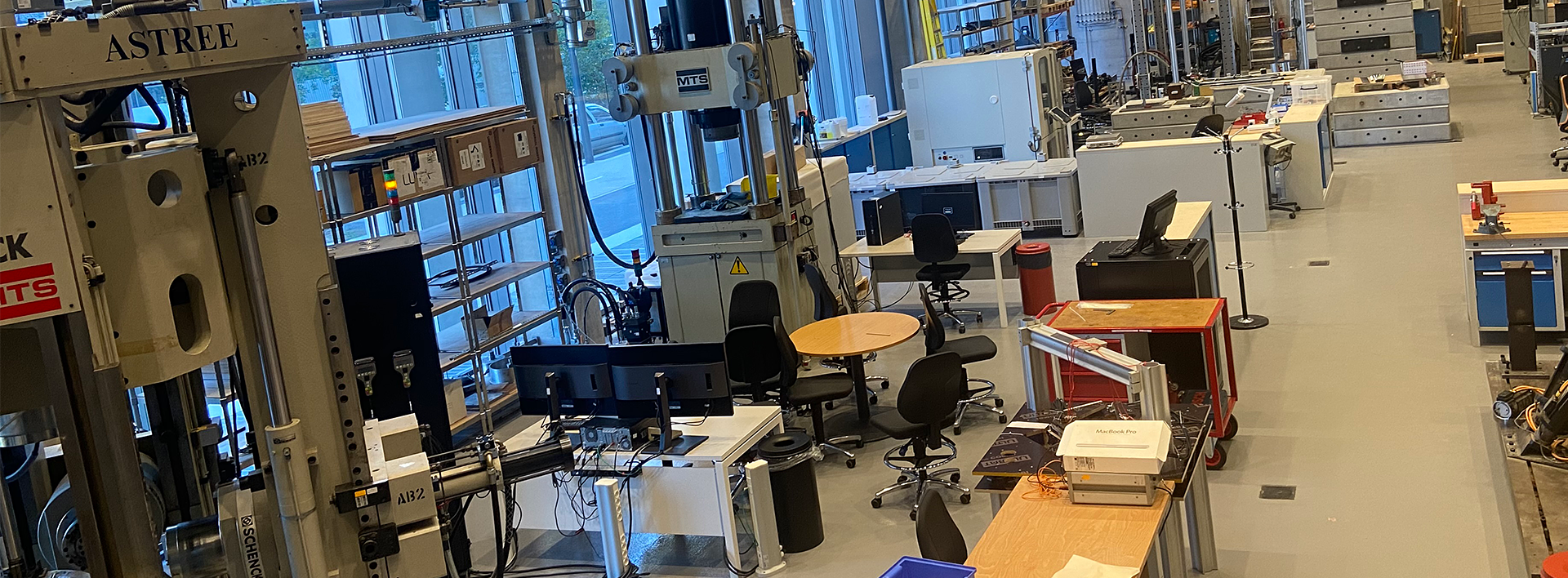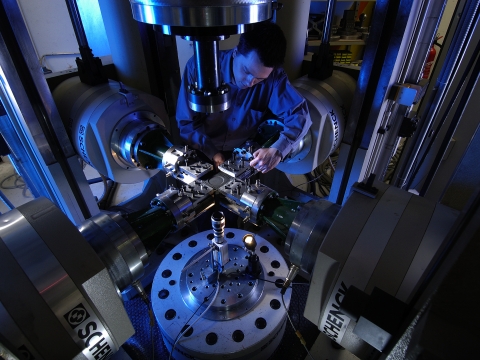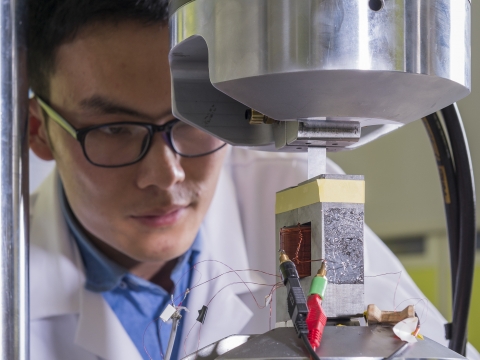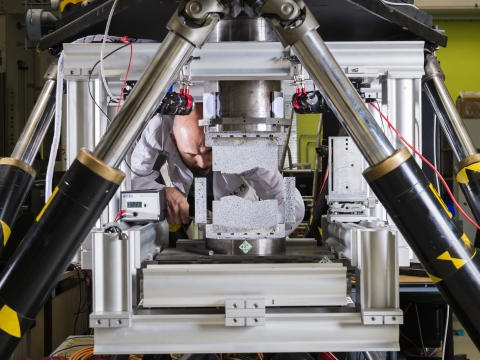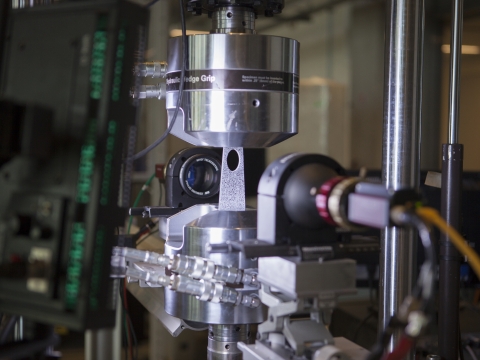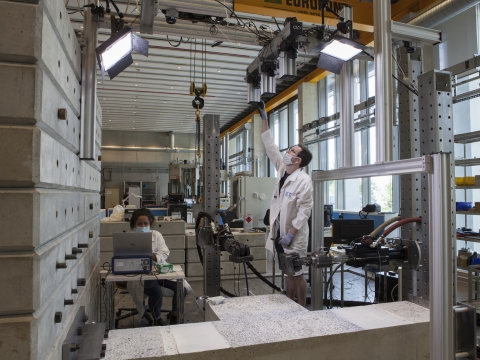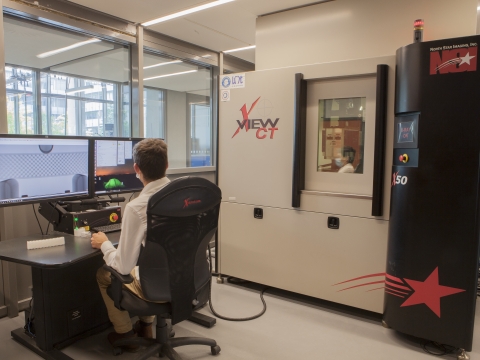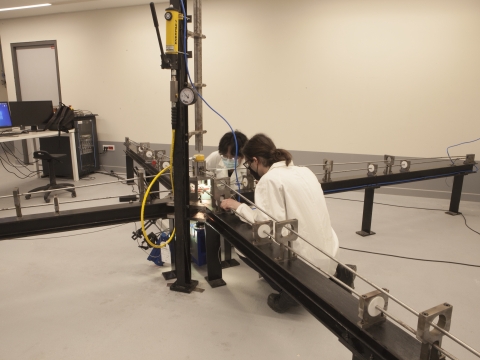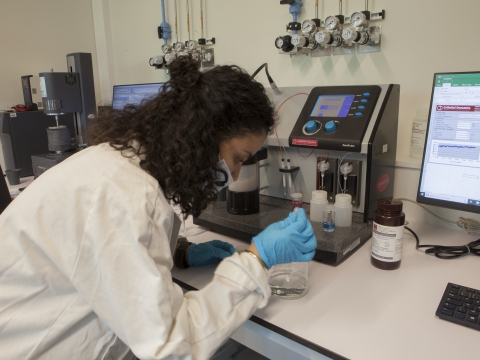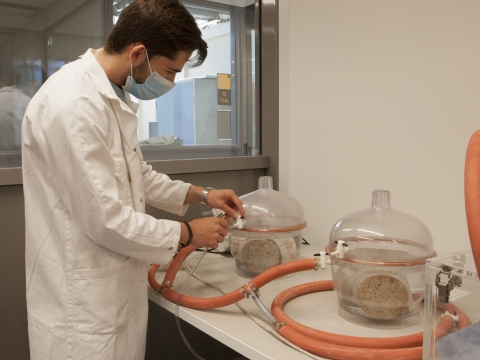Centers
Resources on the ENS Paris-Saclay site
The experimentation and development centre covers an area of approximately 1500 m2. It has a large stock of mechanical, physical and chemical characterisation equipment for materials and structures of millimetre to metre dimensions.
Single and multi-axis load platform
ASTREE triaxial machine
The LMPS has a unique triaxial machine in France called ASTREE. The possibilities offered by ASTREE are to be able to apply a three-dimensional loading on a specimen or a small structure. ASTREE is the result of a joint effort between the LMPS and the company SCHENCK and was created in the early 1990s.
The ASTREE frame consists of a fixed base, four vertical columns, four mobile vertical crosspieces and a mobile horizontal crosspiece. The test space, delimited by the six jacks installed in three orthogonal directions, is 650x650x1500 mm 3 . The two vertical cylinders mounted respectively on the underframe and on the mobile crossbar have a capacity of ±250 kN and a stroke of 250 mm. The four horizontal cylinders have a capacity of ±100 kN and a stroke of 250 mm. The rods of the cylinders are guided by hydrostatic bearings designed to withstand radial forces induced by the other load lines during triaxial testing or in the event of specimen failure. A hydraulic power pack provides a total flow rate of 330 l/min.
The control system, based on Instron multifunction digital electronics (2008), was upgraded in 2018 to take advantage of the performance of recent electronics. Tests on cross specimens carried out on ASTREE are systematically assisted by a displacement field measurement via stereocorrelation codes developed in-house, allowing the verification of specimen loading conditions (homogeneity, alignment) or the identification of local properties.
Removal Astree
Hexapod multiaxial machine
The equipment consists of 6 electric cylinders with a capacity of 25 kN, maximum displacement of 345 mm, and a maximum speed of 275 mm/s. Internal developments have been made to ensure the rigidity of the table and the installation of the machine. A 6-axis force cell with a capacity of 5 kN axial force along each axis and 750 Nm of torque around each axis has been developed and validated.
The aim is to use it to apply complex, highly non-proportional loading paths to specimens or small structures. A particular effort has been made to develop tests on quasifragile materials, in particular, the proposal of a new experimental protocol for the analysis of crack propagation. The boundary conditions are controlled in real time to conform to a predefined crack path.
Traction and compression machines
The laboratory has a number of tensile compression test facilities (2500 kN, 500 kN, 100 kN and 50 kN)
The LMPS is equipped with a modular platform.
This platform is used to carry out mechanical tests on structural elements under quasi-static or dynamic multiaxial loading.
It enables the critical part of a given structure to be stressed in a representative manner.
The platform allows structures of various shapes and stiffnesses to be tested under complex loads and to integrate environmental simulation means (tanks, enclosure, etc.) and various measurement methods.
Analysis platform X
The platform consists of two X-ray characterisation facilities. Each of these pieces of equipment is located in a specific room that meets the needs of the installation. This platform meets the common needs of the laboratory, i.e. phase and stress analysis as well as volume characterisation of various samples, through classical manipulations but also under mechanical, thermal and magnetic stress.
Dynamic experimentation platform
The laboratory has the means to characterise the dynamic behaviour under impact loading of the Hopkinson bar type.
Currently, three 10-metre tracks equipped with a compressed-air gun are used to carry out dynamic compression tests. The test benches allow projectiles to be launched at a speed of 50 m/s for small masses or 12 m/s for larger masses. Large diameter (60 mm) and low impedance (nylon) rods are used, as well as special fixtures to enable unconventional dynamic tests to be carried out: perforation of composite fabrics, shearing of riveted joints, compression of cellular materials.
This experimental platform enables the behaviour and damage of various materials (concrete, HPC, rock, ceramics, composites, foams, etc.) to be characterised.
A particular effort is made to develop original dynamic tests by designing fixtures adapted to the dynamic case (shear, bending, combined shear-compression). Recently, a biaxial compression fixture using a single projectile and two coaxial outgoing bars (one per axis) has also been developed.
Characterisation platform
The platform consists of two rooms, the physical chemistry room and the concrete macroscopy room.
Concrete macroscopy room
The concrete macroscopy room allows mechanical tests and measurements to be carried out on cementitious materials in a controlled environment.
This room is equipped with a temperature and humidity control station. The equipment in this room enables the following to be carried out
- uni-axial and bi-axial creep tests (one bi-axial device and four uni-axial devices) ;
- shrinkage measurements (one automatic and four manual measurement devices)
- setting measurements (Vicat setting device);
- porosity measurements (eight cells);
- storage of specimens for long-term testing.
